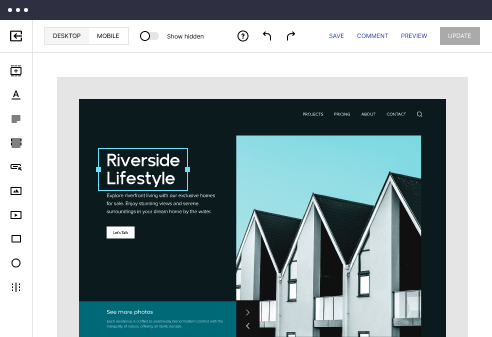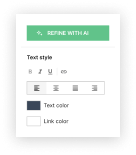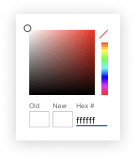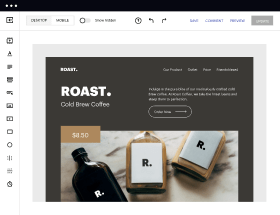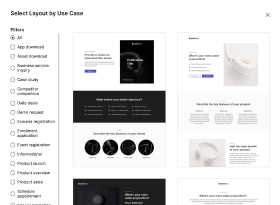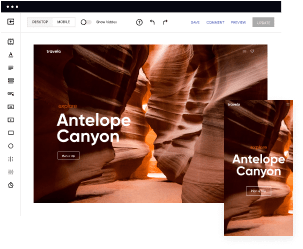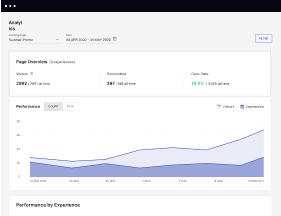React.js optimized opt-in page templates for every professional
Make the most with React.js optimized opt-in page templates. Drive your success today.

Easy to build without coding
With the intuitive drag-and-drop builder, anyone on your team can create high-converting pages without any knowledge of code or design. Make enhancements to your landing page with custom widgets using Javascript, HTML/CSS, or third-party scripts.
Multiple layouts for any industry and goal
Select from 500+ landing page layouts built to boost conversions across industry-specific scenarios. Customize them by adjusting fonts, adding images, and generating on-brand content with the AI assistant. Quickly scale with Instablocks® and Global Blocks that you can save, reuse, and update globally.
Loads fast and looks polished on any device
Every template is responsive, which means they present professionally on any device and load blazingly fast with our Thor Render Engine. You can also power them up with Google AMP technology to deliver an unparalleled mobile experience and drive higher conversions.
Robust analytics & experimentation
Get real-time updates and reporting across all your devices, showing the number of visitors, conversions, cost-per-visitor, and cost-per-lead. Launch AI-powered experiments, run A/B tests, and use heatmaps to analyze user behavior, then optimize your landing page to maximize conversions.
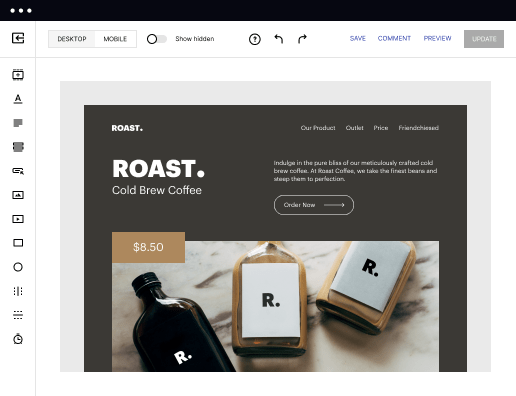
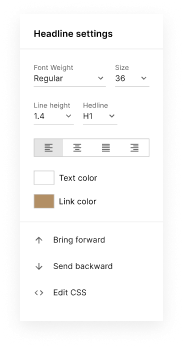
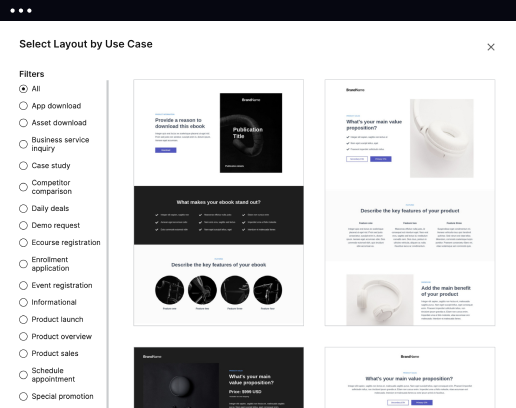
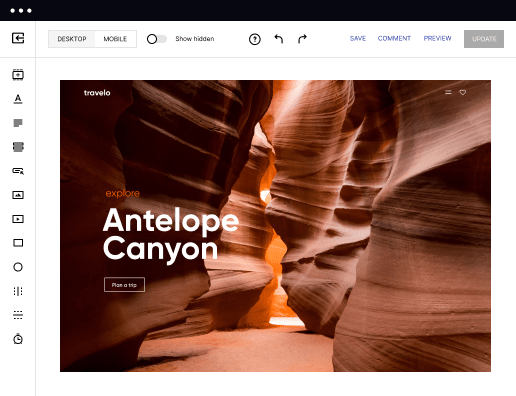
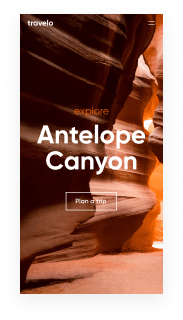
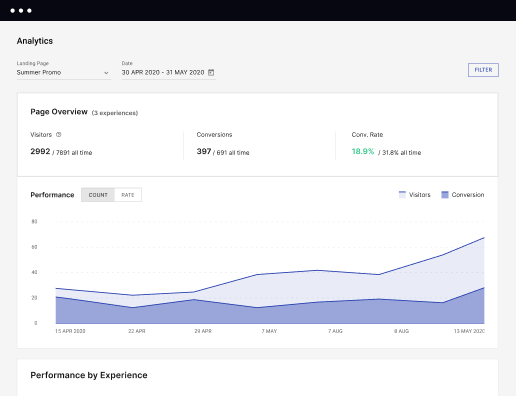
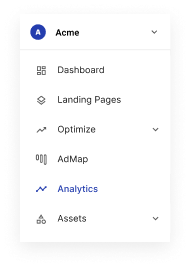
Easy to build without coding
With the intuitive drag-and-drop builder, anyone on your team can create high-converting pages without any knowledge of code or design. Make enhancements to your landing page with custom widgets using Javascript, HTML/CSS, or third-party scripts.
Multiple layouts for any industry and goal
Select from 500+ landing page layouts built to boost conversions across industry-specific scenarios. Customize them by adjusting fonts, adding images, and generating on-brand content with the AI assistant. Quickly scale with Instablocks® and Global Blocks that you can save, reuse, and update globally.
Loads fast and looks polished on any device
Every template is responsive, which means they present professionally on any device and load blazingly fast with our Thor Render Engine. You can also power them up with Google AMP technology to deliver an unparalleled mobile experience and drive higher conversions.
Robust analytics & experimentation
Get real-time updates and reporting across all your devices, showing the number of visitors, conversions, cost-per-visitor, and cost-per-lead. Launch AI-powered experiments, run A/B tests, and use heatmaps to analyze user behavior, then optimize your landing page to maximize conversions.
All the features you need to build lead-generating landing pages
Explore more featuresLearn how to build top-performing landing pages for any goal
FAQs
Leading the way in building high-performing landing pages





Leverage the power of Instapage for your landing pages
Creating an effective landing page is crucial for maximizing your campaign's success. Instapage offers a suite of tools tailored for marketers to enhance their digital strategies. With its extensive library of templates and optimization features, you can efficiently generate high-converting landing pages tailored for various customer segments.
Understanding Instapage's unique capabilities
Instapage is not just a landing page builder; it's an all-in-one Conversion Rate Optimization (CRO) platform designed to simplify and enhance the digital marketing process. By utilizing features like dynamic text replacement, heatmaps, and A/B testing, marketers can ensure their pages engage visitors effectively, leading to improved conversion rates.
- Intuitive page builder: Easily create landing pages with drag-and-drop capabilities, allowing rapid deployment tailored to your business needs.
- Dynamic content personalization: Tailor landing pages based on user demographics to enhance relevance and increase the likelihood of conversion.
- Built-in optimization tools: Experiment with various elements using A/B testing features to determine which designs and copy perform best.
Step 1: Choose the right template
The first step in creating your optimized landing page is selecting a template that aligns with your goals. Instapage provides over 100 conversion-focused templates designed to cater to various industries and objectives. Consider your target audience's preferences when making your choice.
Step 2: Customize your landing page
Once you've selected a template, customization is your next focus. Optimize design elements and include crucial information to pique interest. Use the intuitive drag-and-drop builder to add images, headlines, and call-to-action buttons.
- Capture attention with a strong headline that highlights your value proposition.
- Incorporate engaging visuals to enhance the message and maintain attention.
- Make the call-to-action clear and compelling to drive user action.
Step 3: Optimize for conversions
After customizing your page, it’s crucial to leverage Instapage’s optimization tools. Conduct A/B testing to evaluate different variations and use heatmaps to analyze user interaction on the page. This insight can help refine your strategy to maximize conversion rates.
- Use heatmaps to identify which sections catch user attention and adjust accordingly.
- Conduct ongoing A/B tests to compare versions of your landing page to continually improve effectiveness.
- Analyze conversion metrics through Instapage’s dashboard to track success and iterate on designs.
Follow these steps to harness the full potential of Instapage in creating effective landing pages. Each stage is instrumental in ensuring your digital marketing efforts yield the desired results.
Ready to elevate your marketing campaigns? Explore Instapage today and discover how tailored landing pages can significantly boost your ROI!
People also ask about React.js optimized opt-in page template
Unveiling the power of ReactJS for optimized opt-in page templates
The evolution of landing page development in ReactJS
Landing pages have come a long way from their origins as simple, static web pages. Initially, landing pages primarily served as tools for basic information dissemination. The advent of dynamic content forever changed this landscape, introducing the need for more interactive and engaging user experience. Today, frameworks like ReactJS play a crucial role in the development of modern web applications by enabling developers to create rich user interfaces with ease and efficiency.
The importance of user experience (UX) cannot be overstated when it comes to opt-in pages. A well-designed opt-in page can significantly enhance conversion rates, persuading visitors to take the desired action. Elements such as easy navigation, clear calls-to-action, and fast loading times directly impact user behavior. This makes it essential for marketers to prioritize not just aesthetics but functionality and user engagement.
Transition from static to dynamic pages has transformed user engagement.
React's component-based architecture boosts development efficiency.
User experience design is pivotal for high conversion rates.
ReactJS core features enabling optimization
One of the standout aspects of ReactJS is its component-based architecture. This modular approach breaks down the user interface into independent, reusable pieces, making it easier for developers to manage and build complex applications. For opt-in pages, this means that specific elements such as forms, buttons, and banners can be created as standalone components. These components can then be reused across different pages, leading to more consistent design and reduced development time.
Another significant feature is React’s Virtual DOM, which plays a vital role in rendering efficiency. By maintaining a lightweight copy of the actual DOM, React optimizes updates by only re-rendering components that have changed, rather than the entire page. This leads to faster load times and a smoother user experience, which are crucial for keeping potential customers engaged on opt-in pages.
Component-based architecture promotes code reusability and ease of maintenance.
Virtual DOM minimizes re-renders, boosting performance.
Higher efficiency translates into better user retention and conversion rates.
Leveraging hooks for performance optimization
ReactJS introduces Hooks, a feature that allows developers to manage state and lifecycle events in functional components. One such hook, 'useCallback', is essential for optimizing renders. By memoizing functions, it preserves the function identity between renders. This avoids unnecessary re-renders, which can be detrimental to the performance of an opt-in page, especially one that involves complex user interactions.
Another important hook is 'useMemo'. This hook allows developers to memoize expensive calculations, meaning those computations will not be recalculated on every render unless their dependencies change. For example, when validating input on an opt-in form, useMemo can be leveraged to ensure that validation logic runs only when the specific input changes, enhancing performance and user experience.
'useCallback' helps prevent unnecessary function recreations.
'useMemo' optimizes performance by avoiding expensive calculations on every render.
Throttling user input enhances performance by limiting the number of renders.
Building a dynamic opt-in page using ReactJS
To start creating a landing page using ReactJS, the first step is to set up a new project. This can easily be accomplished using Create React App, a command-line tool that sets up all the necessary configuration automatically. After initializing the project, it’s important to establish a project structure that accommodates scalability. This might include folders for components, utilities, and styles to ensure organized development.
Utilizing React components for user interaction is where the magic happens. Interactive components such as forms, dropdowns, and buttons need to be crafted to guide the user seamlessly through the opt-in process. Special attention should be paid to designing captivating call-to-action buttons. These buttons are crucial for conversion, making it essential that they stand out visually and deliver clear messaging.
Step-by-step project setup improves ease of development.
Organized folder structure fosters maintainability and scalability.
Interactive components enhance user engagement on landing pages.
Optimize user experience with list visualization
Lists play an essential role in effectively showcasing benefits on an opt-in page. Crafting enticing bullet points that highlight key offerings can draw users in and maintain their interest. Implementing animated lists can further enhance engagement, providing a visually appealing way to present information without overwhelming the user.
In addition, effective techniques for list rendering should be employed. For instance, React’s Fragment can be used to group list items without introducing additional elements in the DOM, which helps maintain clean code and improves performance. Meanwhile, conditional rendering can lead to personalized user experiences, allowing different content to be displayed based on user interactions or profile data.
Lists effectively communicate benefits and features.
Animated lists build engagement and improve user experience.
Conditional rendering allows for personalized content delivery.
Advanced performance tuning in web applications
Identifying performance bottlenecks is crucial for any React application. Common pitfalls that can lead to sluggish performance include unnecessary re-renders, large bundle sizes, and improper use of hooks. By employing tools like React Profiler, developers can pinpoint areas for improvement, ensuring a seamless user experience on opt-in pages.
Furthermore, strategies for reducing bundle size are worth considering. Implementing code splitting and lazy loading can split the application into smaller chunks, loading only the necessary code when required. This can greatly improve initial load performance. Additionally, techniques like tree shaking can be used to eliminate unused code from the final bundle, keeping the application lightweight and efficient.
Identifying bottlenecks aids in optimizing application performance.
Code splitting accelerates the initial loading experience.
Tree shaking minimizes the bundle size by removing unused code.
Real-world examples of optimized opt-in pages
Analyzing high-converting opt-in pages built with React can provide invaluable insights for marketers. Case studies often reveal specific design elements and functionalities that lead to increased user engagement and higher conversion rates. Conversely, examining failed attempts highlights what pitfalls should be avoided, offering a clear path toward better design decisions.
A practical approach to understanding these concepts is through a DIY optimized opt-in page template. This includes a detailed code example that illustrates the application of optimizations discussed throughout this article. Customization aspects should be highlighted, allowing developers to adapt the template to their specific needs and improving its functionality and overall performance.
Case studies provide insights into effective design strategies.
Learning from failures guides better design decisions.
A DIY template allows for hands-on implementation of best practices.
The future of optimized web applications with ReactJS
The future of landing page development is likely to be shaped by trends such as AI-driven personalization. By utilizing machine learning algorithms, landing pages can be dynamically adjusted in real-time to suit individual user preferences and behaviors. This can greatly enhance the effectiveness of opt-in pages by delivering content that resonates with each unique visitor.
In addition, headless CMS integration with React applications will enable even greater flexibility and efficiency. Marketers will be able to pull dynamic content from a variety of sources without being restricted by traditional content management systems. Community engagement and continuous learning will also play a pivotal role, as developers share insights and resources to further refine their skills in React development.
AI-driven personalization enhances user engagement on opt-in pages.
Headless CMS integration offers flexibility in content management.
Community engagement fosters continuous learning and improvement.
Key takeaways from an optimized ReactJS opt-in page template
ReactJS has transformed the landscape of landing page development by providing tools that significantly improve performance and user engagement. By capitalizing on features such as component-based architecture and Virtual DOM, developers can create optimized opt-in pages that not only load faster but also drive higher conversion rates. The use of hooks further fine-tunes application performance, ensuring that interactions remain smooth and responsive.
As we continue to explore and experiment with ReactJS for building landing pages, it is essential to prioritize user experience design and regularly analyze performance metrics. By embracing innovation and staying curious, marketers can leverage ReactJS to create compelling, high-converting opt-in pages that elevate their brand and grow their customer base.
React offers features that enhance performance and user engagement.
User experience design is central to high-converting opt-in pages.
Continuous experimentation ensures long-lasting success.
Ready to skyrocket conversions?
Supercharge your ad campaigns with high-performing landing pages
Get started